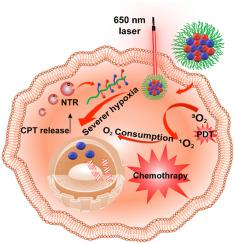Journal of Controlled Release ( IF 10.5 ) Pub Date : 2021-09-21 , DOI: 10.1016/j.jconrel.2021.09.023 Qinghao Zhou 1 , Fathelrahman Mohammed 1 , Yuheng Wang 1 , Jingbo Wang 1 , Nannan Lu 2 , Junjie Li 3 , Zhishen Ge 1

|
The inherent hypoxic microenvironment of solid tumors has an important influence on tumor growth, distant metastasis, and invasiveness. The heterogeneous distribution of hypoxic regions inside tumors limits the therapeutic efficacy of O2-assisted therapeutic strategy (e.g. photodynamic therapy (PDT)). On the other hand, the hypoxia-activable prodrugs cannot work effectively in the regions with enough O2 concentration. To address the issues, we prepare a block copolymer polyprodrug consisting of polyethylene glycol (PEG) and copolymerized segments of nitroimidazole-linked camptothecin (CPT) methacrylate and 5,10,15,20-tetraphenylporphyrin (TPP)-containing methacrylate monomers for complementary photodynamic-chemotherapy. The polyprodrug can self-assemble into polymeric micelles in aqueous solution with suitable size and high stability. After intravenous injection, the polyprodrug micelles show tumor accumulation. Followed by light irradiation (650 nm) at tumor sites, TPP moieties induce singlet oxygen (1O2) production in the oxygen-rich area to exert PDT and cause transformation of the oxygen-rich areas into hypoxia. Simultaneously, in the hypoxic areas, the hypoxia-responsive polyprodrugs can be activated to release free CPT due to the cleavage of nitroimidazole linkages. The polyprodrug micelles with the segments for PDT and hypoxia-activable CPT efficiently suppress the growth of HeLa tumors. The well-defined polyprodrug amphiphiles offer an effective strategy to overcome the disadvantages of single treatment of PDT or hypoxia-responsive prodrugs for complementary photodynamic-chemotherapy of cancers.
中文翻译:

用于互补光动力化学疗法的缺氧反应性嵌段共聚物聚前药
实体瘤固有的缺氧微环境对肿瘤的生长、远处转移和侵袭性有重要影响。肿瘤内缺氧区域的异质分布限制了O 2辅助治疗策略(例如光动力疗法(PDT))的治疗功效。另一方面,缺氧激活的前药在O 2足够的区域不能有效发挥作用。专注。为了解决这些问题,我们制备了一种嵌段共聚物聚前药,由聚乙二醇 (PEG) 和硝基咪唑连接的喜树碱 (CPT) 甲基丙烯酸酯和含有 5,10,15,20-四苯基卟啉 (TPP) 的甲基丙烯酸酯单体的共聚链段组成,用于互补光动力- 化疗。该聚前药可在水溶液中自组装成大小合适、稳定性高的聚合物胶束。静脉注射后,聚前药胶束显示肿瘤积聚。随后在肿瘤部位进行光照射 (650 nm),TPP 部分诱导单线态氧 ( 1 O 2) 在富氧区生产,以发挥 PDT 作用,使富氧区转变为缺氧区。同时,在缺氧区域,由于硝基咪唑键的断裂,缺氧反应性多前药可以被激活以释放游离的CPT。具有 PDT 和缺氧激活 CPT 片段的多前药胶束有效地抑制了 HeLa 肿瘤的生长。明确定义的多前药两亲化合物提供了一种有效的策略来克服 PDT 单一治疗或缺氧反应性前药对癌症进行补充光动力化学疗法的缺点。











































 京公网安备 11010802027423号
京公网安备 11010802027423号